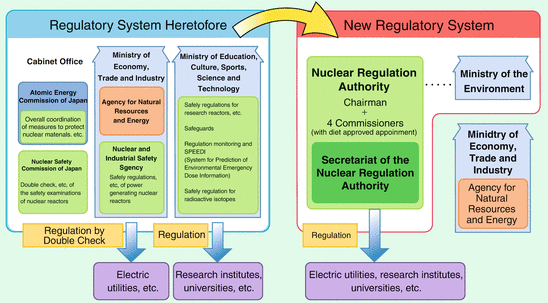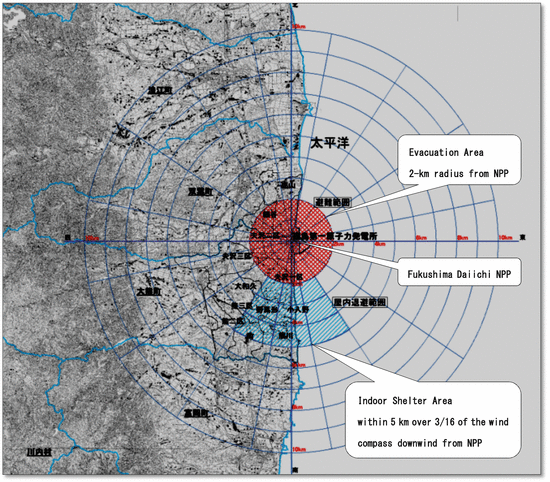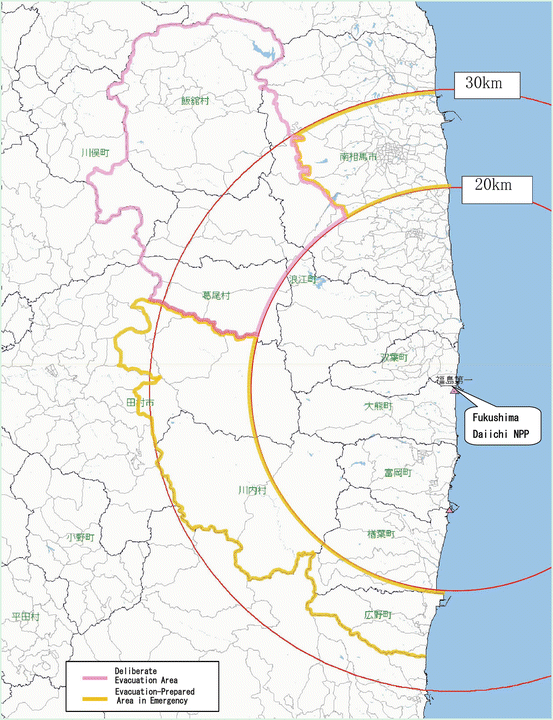Fig. 2.1
Legal system for nuclear power safety regulations in Japan (Source: MEXT (http://www.mext.go.jp/english/science_technology/1303809.htm))
After the radiation leakage that occurred in 1974 aboard the nuclear-powered ship Mutsu, criticism grew over the fact that the AEC, an organisation that promotes nuclear power, had jurisdiction over safety regulations. In October 1978, the NSC split from the AEC and was established as a new agency. With the JCO accident and TEPCO’s damage cover-up and data falsification that were uncovered in 2002, the Nuclear Reactor Regulation Act was revised, and NSC’s functions and disaster countermeasures were strengthened.
Even prior to the Fukushima accident, the independence of these organisations and agencies had been an issue. NISA was situated within METI, which promotes nuclear energy, thus inhibiting NISA from providing sufficient regulation, not to mention the fact that it was sometimes even charged with promoting nuclear energy. The role of the NSC, which was to monitor NISA regulations, was beginning to become a mere façade [1]. Article 8 of the Convention on Nuclear Safety (ratified by Japan in 1995) demands the effective separation of duties between agencies promoting nuclear power use and regulatory agencies. In addition, the International Atomic Energy Agency’s Fundamental Safety Principles (1996) also demand the independence of regulatory agencies. Moreover, ‘The Efforts towards Ensuring the Safety of Nuclear Power Plants in the Future’ compiled by Fukushima Prefecture in June 2005 points out that ‘NISA should be separated from METI and its promotion of nuclear power generation’ in order to establish a more objective structure and gain the trust of citizens and regions [2].
In October 2012, after the Fukushima accident, the Nuclear Regulatory Commission (NRC) was created as an external agency of the Ministry of the Environment to do away with the negative effects of vertically siloed administrative agencies dealing with nuclear power use and to resolve issues stemming from one organisation being responsible for both nuclear power promotion and regulation (Fig. 2.2). In addition to the work done by the NSC and NISA, the NRC now has jurisdiction over nuclear safety regulations of the Ministry of Education, Culture, Sports, Science and Technology and the Ministry of Land, Infrastructure and Transport as well as having jurisdiction over measures that guarantee nuclear non-proliferation.


Fig. 2.2
Reform of regulatory agencies for nuclear power safety (Source: NRC (http://www.nsr.go.jp/data/000067218.pdf))
2.3 Evacuation Plans That Did Not Plan for Severe Accidents
When nuclear power plants were first built in Japan, nuclear emergency responses were based upon the Basic Act on Disaster Control Measures (Act No. 223 of 1961), with ‘large emissions of radioactive materials’ defined as one type of disaster falling under this Act by government decree. The disaster prevention structure was created on the basis of the Basic Disaster Management Plan set forth by the Central Disaster Management Council and the ‘Disaster Prevention Measures for Nuclear Power Plants and Surrounding Areas’, which was a set of disaster response guidelines created by the NSC.
However, the JCO accident in 1999 was serious enough to require evacuation and indoor shelter of residents, which was a first for Japan, and it brought to light the inadequacies of the disaster prevention structure in place at the time. The Act on Special Measures Concerning Nuclear Emergency Preparedness (Act No. 156 of 1999) was enacted after that accident in 1999 as a special provision of the Basic Act on Disaster Control Measures and the Nuclear Reactor Regulation Act [3]. This act clarifies the standards for notifications from plant operators and the declarations of states of emergency by the Prime Minister to ensure rapid initial responses. During nuclear disasters, there exists a possibility that damage unperceivable by the senses might occur; therefore, the act sets forth the role and responsibility of the national government, strengthens partnerships between the national government and local governments and clarifies the responsibilities of plant operators. Article 13 of the act stipulates coordinated disaster prevention drills between the national government, local governments and related plant operators on the basis of the plans set forth by the national government. A disaster response guideline established by the NSC has traditionally only targeted large-scale facilities such as nuclear power plants. This has been revised with a section on ‘disaster response for nuclear power facility’ that includes fuel-processing operations.
However, the preaccident disaster response guideline has been criticised for not incorporating results from the analysis of the Chernobyl accident [4]. The guideline has set an emergency planning zone (EPZ) of 8 and 10 km from nuclear power plants where disaster responses are focused. This distance was decided upon because ‘making a larger EPZ would only have a negligible impact given a drastic reduction in the impact of radiated materials and radiation from nuclear facilities the farther one gets from the source of emissions.’ In setting the size of the EPZ, ‘even technologically impossible situations were supposed, and an ample distance from nuclear facilities was set.’ It was confirmed that outside this perimeter, there would be no need to take shelter indoors or to set up protective measures for evacuees. Relationships with prior accidents were also considered in creating the guidelines [5].
Originally, there were no disaster response plans in Fukushima Prefecture for nuclear disasters. After the Three Mile Island (TMI) accident in 1979, the Prefecture created its first disaster prevention plans, which were later revised. The Prefecture also conducted disaster prevention drills. However, in 2008, the comprehensive nuclear energy disaster prevention drill sponsored by the national government based on Article 13 of the Special Measures Act set the evacuation area to within only a 2-km radius from the nuclear plant and indoor shelter area to within 5 km over 3/16 of the wind compass (72° angle) downwind from the plant (Fig. 2.3).


Fig. 2.3
The emergency response area under the 2008 comprehensive nuclear energy disaster prevention drill (Source: METI (http://www.meti.go.jp/committee/materials2/downloadfiles/g81006b02j.pdf))
On 11 March 2011, at 8:50 p.m., the Governor of Fukushima Prefecture issued an evacuation order to the residents in a 2-km radius. Later, the residents in a 3-km radius were ordered to evacuate at 9:23 p.m. by the Prime Minister. On 12 March at 5:44 a.m., the order was extended to the residents living within 10 km and then at 6:25 p.m. to the residents living within 20 km. On 15 March at 11:00 a.m., areas within a 20- to 30-km radius were designated as an indoor shelter zone (Fig. 2.4). For the village of Iitate and other villages that registered high levels of radiation but were outside the restricted area, a deliberate evacuation area and specific spots where evacuation was recommended were established on 22 April 2011, though the confusion continued. As a result, ‘in the town of Namie, residents near the nuclear plant were evacuated to a remote location. However, on the 15th, that location was notified of danger, forcing a further evacuation to the city of Nihonmatsu. Unfortunately, this evacuation path followed the direction the radioactive materials were blowing in. Similarly, the town of Tomioka first evacuated to the village of Kawauchi, and from there the residents of that village and those from Tomioka were re-evacuated to the city of Koriyama’ [6].


Fig. 2.4
Establishment of deliberate evacuation areas (Source: METI (http://www.meti.go.jp/press/2011/04/20110422004/20110422004-5.pdf))
Evacuations of medical institutions, homes for the elderly, welfare facilities, hospice care patients at home and the severely disabled were fraught with extreme difficulty [7–9]. Of the six hospitals designated as initial exposure medical institutions in times of a nuclear disaster, four had to evacuate all patients in their care. For hospitals that had conducted disaster prevention drills under the assumption they would be receiving patients, these were completely unforeseen circumstances [10].
The NRC, which was newly created after the accident, decided upon the nuclear disaster response guidelines in October 2012, which they later revised multiple times. To prepare for a large-scale complex disaster and ensure the efficacy of protective measures for residents, evacuation standards were clarified. A Precautionary Action Zone (PAZ) was created to prepare precautionary protective measures. An Urgent Protective Zone (UPZ) was created to prepare urgent protective measures in case of broad evacuations: standards (Operational Intervention Level; OIL) were issued to determine whether such protective measures would be implemented. However, many issues still remain regarding the preparedness for persons having difficulties in evacuating by themselves and the execution of effective disaster prevention drills [11].
Stay updated, free articles. Join our Telegram channel

Full access? Get Clinical Tree





